
20 minute read
Syd Is Really Unrecognized For The Contributions He Brought To Comics
A Star-Spangled Salute to SYD SHORES – Part II 19 “Syd Is Really Unrecognized For The Contributions He ALLEN BELLMAN On His Friend & Colleague, Brought To Comics” Syd Shores Conducted & Transcribed by Richard J. Arndt I NTERVIEWER’S INTRODUCTION: Allen Bellman began his comics career in October 1942 when he answered an ad that led to RICHARD ARNDT: We’re welcoming Allen Bellman, one of the last surviving 1940s artists to have worked on the original Captain America a job at Timely Comics. He worked comic, to reminisce about his old friend, in the Timely bullpen as both inker Syd Shores. Welcome, Allen! What can and penciler-inker until 1949, when you tell us about Syd? he became a freelancer. He continued working as such with Timely/Atlas and ALLEN BELLMAN: When I came also began taking assignments from there, to Marvel, he was already Lev Gleason Publications in 1950. He working on Captain America, penciling left the comics industry in 1953. Most the lead story and other work as comics historians believed him to be the time permitted. He was inked by a last of the Timely (non-humor) artists gentleman named Vince Alascia. from the early 1940s alive. He was also the author of Timely Confidential: When the Golden Age of Comics Was Young (2017). Allen Bellman passed away on March 9, 2020. This interview was conducted July 16, 2018. RA: Alascia used to do a lot of work for Charlton in the 1950s, ’60s, and ’70s, usually inking Charles Nicholas. He also worked on Jack Kirby’s pencils in the 1940s and 1950s. But we should probably start with when you first met Syd.
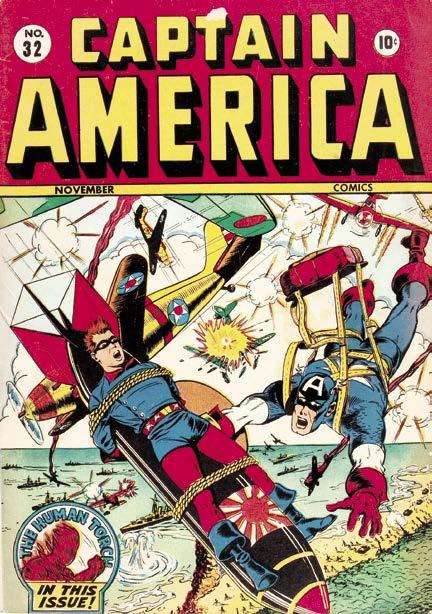

Allen Bellman Sadly, we don’t have a photo of the late artist Allen Bellman with his Golden Age colleague, Syd Shores— but here’s one of Allen with Syd’s daughter, Nancy Karlebach—flanked by images drawn by both men. (Left:) Shores’ cover for Captain America Comics #32 (Nov. 1943) depicts the hero rescuing his young ally Bucky, who’s strapped to a plummeting bomb. Courtesy of the Grand Comics Database. (Right:) Besides later working unheralded on various “Captain America” stories, Allen drew the Cap-derived “Patriot” for Marvel Mystery Comics #62 (March 1945). Scripter unknown. Thanks to Dr. Michael J. Vassallo. [TM & © Marvel Characters, Inc.]
BELLMAN: OK. I was hired in 1942 at Timely. The reason was because Jack Kirby and Joe Simon had left Timely and absconded over to National, DC Comics. Timely put out an ad for artists and I went over there and got the job. I was hired by Don Rico. I was to report in the following Monday, so I came in and Rico introduced me to the people on the staff, including Syd Shores. I had the sense of something not right going on in that office.
Syd really had [artist & writer] Don Rico on his back. You could really feel it in the air. A jealousy thing. Now that I look back, I think that Don Rico was jealous that Syd Shores had got the lead assignment on penciling Captain America. That’s my own opinion.
There were other freelance artists penciling him too, but Syd was the lead one. I was just hired to be in the bullpen.
RA: You mentioned that Don Rico hired you. Would that mean he was the art director of Timely at that time? BELLMAN: No! I never actually knew who the art director was at the time. Years later I found that Vince Fago was considered the art director in 1942, but I never saw him when I was hired. I met him later but had no idea that he was the art director. [NOTE: Apparently Fago served as the interim art director (as well as the comics line’s editor) from Dec. 1942 until 1945 for Timely when Stan Lee was in the service. After 1945, Lee again held that title through the early 1970s when he became publisher and president—and even then, he didn’t officially relinquish it to anyone else for several years.]



Don Rico & Vince Fago (Left:) Writer/artist Don Rico, circa 1942. Both he and Bellman were highlighted back in Alter Ego #114, which see! A detail from the famed “Bambi” photo. (Right:) Vince Fago was also a writer and artist, primarily of humorous comics—and in late 1942 became Timely’s editor when Stan Lee joined the Army. This photo was taken in 1948.
After I started at Timely I became very good friends with Syd. I was doing the backgrounds on his pages for Captain America. Syd and his wife were a huge help to me when I got divorced from my first wife. That was a dark period in my life. They were great people and treated me great.
RA: Al Avison preceded Syd on Captain America, is that correct? BELLMAN: Avison was a freelancer. Syd was in the bullpen, but, yeah, I think Al did the lead stories for Captain America before Syd took over. I never saw him. Never saw Jack Kirby or Joe Simon, either. They were both gone before I got there. Syd was the main Captain America artist all the time I was there, right up to the end of the comic in 1949.
RA: How many people were in the bullpen at that time? BELLMAN: We had an animators’ department, which I never had too much to do with, and then the guys working on the super-hero and adventure books. That’s where Syd and I were. Maybe 20, 25 people. It’s hard going back to 1942 and figuring how many people might have been working in the bullpen then. I’m 94 and I’m lucky some days to remember what I had for breakfast.
RA: You and me both. [laughs] What else, if anything, was Syd also working on at Timely during this period? BELLMAN: Captain America probably kept him pretty busy, but I’m sure they gave him other assignments when they could. If they didn’t have a Cap story “We’ll Always Have Paris!” available, they’d give In drawing many of the World War him something else. He
II-era covers of Captain America Comics, was a good artist. They such as this one for #29 (Aug. 1943), weren’t going to waste
Shores was following the lead of Alex him!
Schomburg, who delineated most of the
Human Torch, Sub-Mariner, and Marvel RA: I probably should
Mystery Comics covers of that era—with remind modern-day readers a horde of people and paraphernalia of this interview that, in crowding the canvas, many of them those days, comics were labeled for clarity. The signs and strewn- 64 pages long, not 32 about papers in this one reveal that Cap and Bucky are coming to the rescue of members of the anti-Nazi French underground. The GCD suggests that pages as they generally are today, and there weren’t that many advertisements perhaps Syd had an inking assist—by included. There were an unidentified artist—on it. probably more than 50 [TM & © Marvel Characters, Inc.] pages of content at the time. [NOTE: In fact,
much more—Captain America Comics #11 had 63 pages of editorial content out of 64 pages! The pages for a monthly like Captain America may well have taken all of his time and more.] BELLMAN: Syd was a fast penciler, but his work was also very accurate. Very true-to-life. The clothes were right. The buildings were right. He was a very good artist. Later on, he was not treated right. There was a point in time when Syd was pushed back when they brought in a lot of editors. Stan Lee did not protect Syd then, and I found that troubling. But I’ll wait for you to ask the questions about that. a bit older than most of the staff, but nobody was really too old in those days. BELLMAN: He was pretty old to me! I was 18 and he was 30. He’d been at Timely at least a couple of years before I got there. But to an 18-year-old, anybody 30 years old is an old guy. There were a lot of pretty good artists there, but most of us were young! There were also a lot of crude artists, because they were young and not fully developed. Carl Burgos, the creator of The Human Torch, sat behind me in the bullpen, and his art was somewhat crude. The Human Torch was a really good idea, though.
Syd himself was not young. He was mature. His artwork reflected that. It was strong, mature work. He was a truly good artist. His penciling may not have stood out on its own, but when inked it was just good art. His composition was strong. His work on body parts was good. His flow from page to page was good. He also knew how to take a script and make it look good when it went to print.
RA: Stan Lee was an editor at Timely early on, but was he the only editor at Timely? BELLMAN: At that time? When I started, he was not even there. I think he was already in the service or maybe just getting ready to go into it. After I’d been there two or three weeks, I saw a little guy walk in whose name was Robby Sullivan. He was a brother-in-law to Martin Goodman. Stan Lee, whose real name was Stanley Lieber, was related to Robby Sullivan. There was some sort of family relationship there between Goodman, Sullivan, and Stan Lee.

RA: I’ve got a note here where Syd said in an interview he gave in the early 1970s that he worked on Captain America from 1942-1944, and then was drafted. He ended up in the same regiment as Jack Kirby, although I don’t think they ever met during the war years. Syd certainly never mentions meeting him then. BELLMAN: Thank God he came back alive from the war!
RA: I also have a note quoting Gene Colan, where he says he started at
“I Was There!” On the comics convention circuit at age 92, Bellman drew (and reproduced limited editions of) such drawings as this one for fans of Golden Age comics. Thanks to Allen for sending it to us, a few years back. [Captain America & Bucky TM & © Marvel Characters, Inc.; other art © Estate of Allen Bellman.]
RA: Sure. How old was Syd when you first met him? I believe he was
Timely in the summer of 1946.

Cap’s In The Air Gene Colan drew a “Captain America” yarn or two in the late Golden Age— such as this splash from Captain America Comics #71 (March 1949)—and would draw a whole lot more in the late 1960s, when he teamed up with Smilin’ Stan Lee. 1940s scripter unknown. Thanks to Dr. Michael J. Vassallo. [TM & © Marvel Characters, Inc.]


Another Marvel Mystery! We don’t know how many stories about Timely’s original “Big Two” Syd Shores drew in the 1940s—but he definitely penciled a number of covers of both heroes’ mags. Juxtaposed here are those of Human Torch #29 (Winter 1947) and Sub-Mariner #23 (Summer ’47), both possibly inked by Vince Alascia. Thanks to the GCD. [TM & © Marvel Characters, Inc.]

BELLMAN: Yes, I knew him then, but we didn’t become the really good friends we were to become until fifty years later. Gene was a nice, curly-haired kid with a lot of talent.
RA: My notes say that he considered Syd the top man in the art department, which, I guess, means that Syd by this time was acting as the de facto art director for Timely. BELLMAN: He was never officially the art director. He was the head artist. Stan was both the Editor and Art Director. Stan was pretty green back then, though. He was only a year-and-a-half older than I was. Nineteen, 20, 21, no more than that. Now, I say that Stan was green, but he caught on really quick. He really made Timely, then Atlas, then Marvel Comics really work!
RA: OK! Gene describes Syd as a really quiet kind of guy. BELLMAN: Really quiet. He did his work and didn’t talk much. When his daughter Linda was born, there was a popular song about a gal named Linda and he’d sing that. [NOTE: Almost

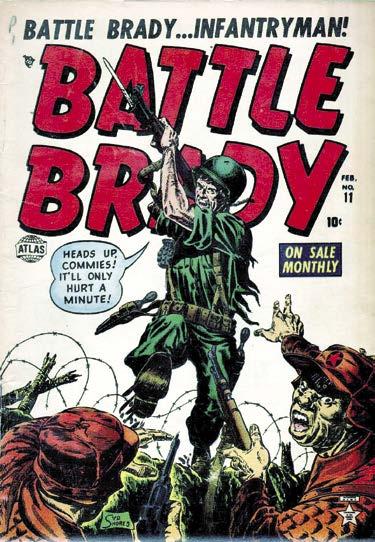
“A Lot Of Westerns… [And] A Lot Of War Comics” Three dynamic illustrations from Shores-“covered” genres mentioned by Allen Bellman: the covers of Kid Colt Outlaw #6 (July 1948), Black Rider #20 (Jan. 1954), and Battle Brady #11 (Feb. 1953). Stan Goldberg colored at least the latter two of these. The Kid Colt cover inker is unidentified. Courtesy of Dr. Michael J. Vassallo and the GCD.[TM & © Marvel Characters, Inc.]

“Wild” In The Studio Allen Bellman may not recall his fellow Golden Age artist Mort Lawrence, but ML and Syd Shores even teamed up at one time to try to sell the above-depicted Stella Fortune daily comic strip, with the penciled panels probably being the latter’s work. The probably Shores-written text taped onto it tells its story… but alas, as with 99% of all attempted comic strips, it failed to sell. [© Estates of Syd Shores & Mort Lawrence.] Both men drew at times for Patches Publications’ The Westerner Comics. Shores did the “Wild Bill Pecos” lead story in #32 (Jan. 1951), while Lawrence illustrated a “Wild Bill” exploit in #27 (June 1950). Both stories are attributed to William Woolfolk as scripter. [© the respective copyright holders.]

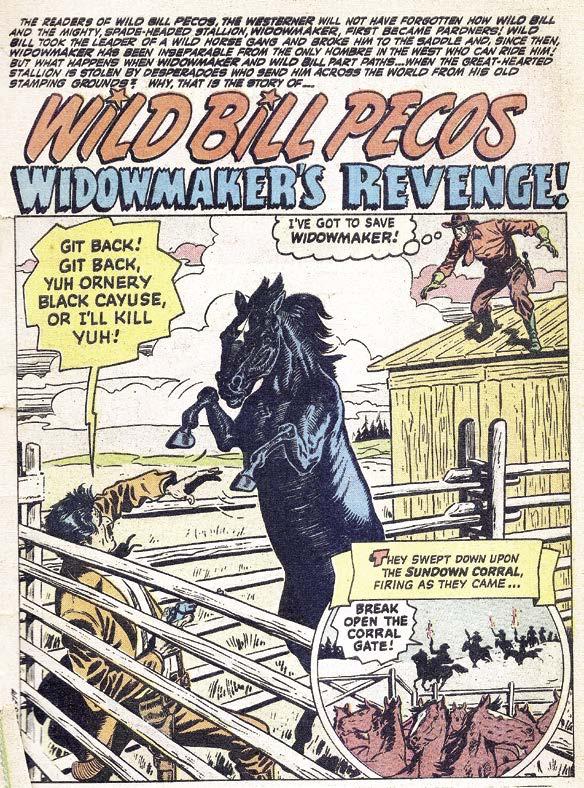
certainly the 1946 Buddy Clark tune.] Just occasionally. Then, when Nancy was born, he’d sing “Nancy (with the Laughing Face).” [NOTE: A 1945 Frank Sinatra recording.] I remember when they both were born. In fact, I’m very friendly with Nancy and her husband and family right now.
RA: That’s nice. I think it’s kind of sweet that he would sing songs about his daughters as well. There are records that indicate that, after the war when the comics began shrinking in size, he worked on both “Human Torch” and “Sub-Mariner” stories.
BELLMAN: That I don’t know about. He did beautiful work on Westerns. Kid Colt, Black Rider… He did a lot of Westerns but I don’t remember all of them. He also did a lot of war comics. Actually, we all did a lot of war comics. I enjoyed drawing those and I think Syd did as well.
RA: Syd founded a comics art studio in the 1950s. Were you involved in that?
BELLMAN: Yeah, there was Syd, me, another guy, a background guy, whose name I don’t recall. It was in Hampstead, Long Island. We both lived in that neighborhood. I was in the art studio. We each paid a fee for that.
RA: I have two other gentlemen whose names are listed—Mort Lawrence and Norman Steinberg. BELLMAN: The first name doesn’t ring a bell, and the second one… I’m just not sure.
RA: I’d also like to discuss the layoffs or firings of the bullpen that took place from time to time, starting in 1949 and going through to the big one in 1957.
BELLMAN: Yeah. Every department at Timely or Timely-Atlas had a benchmark. When those benchmarks came around, every day somebody was called in and fired. After I was fired, I personally ran over to Lev Gleason and got a new job right away. Syd got fired and then re-hired as a freelancer by Timely within a day or two of each other. Maybe even quicker than that.
When there were no comics to be worked on, they gave Syd illustrations for this or that to do.
In 1957 it was different. A lot of companies were gone. Atlas, I guess it was called at that time, canceled a lot of books, which gave them enough inventory for the few books that were remaining to keep going for a while. Maybe even as long as a year or a year and a half.
We both had to leave comics around then. I remember going to his house and seeing illustrations and covers that he was doing for various magazines. They were absolutely wonderful! The interiors were done in washes—light grays and dark grays. He couldn’t make enough money on that, though. He told me that. He had a lot of offers. The editors of those magazines tried to keep him busy, but the volume of work wasn’t enough to take up all the comicbook pages that he couldn’t do anymore.
I remember being in his house when he was laboring over an illustration for one of those magazines. It was like a house of mourning.

RA: I think he was doing advertising at that time as well.
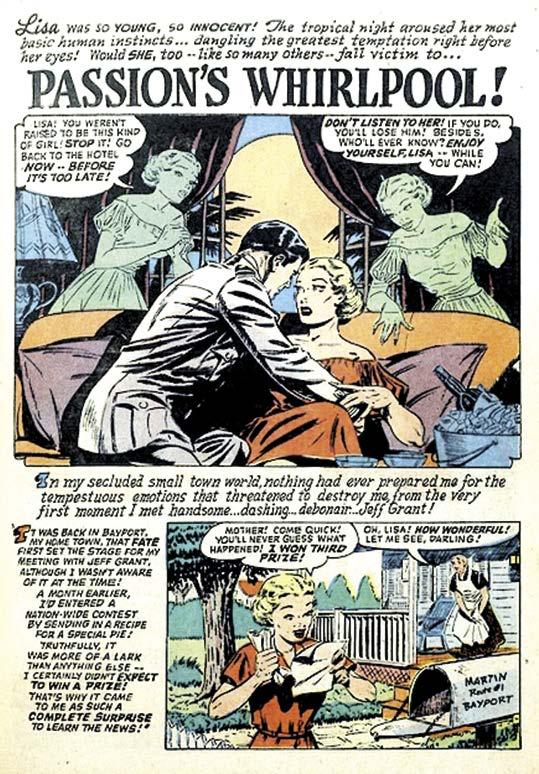

Casting A Wide Net (Left:) Once he was no longer on staff at Timely after 1949, Shores sometimes accepted freelance assignments from other companies—such as Orbit-Wanted, for whom he penciled this yarn for Love Diary #32 (Dec. 1952). Whether or not he inked it as well is as unknown as the name of the lovestruck scripter. Thanks to Jim Kealy. [© the respective copyright holders.] (Center:) Of course, Syd’s Timely work was also reprinted abroad, whether he was working for the company at the time or not—as witness the Canadian cover (from the Bell group) displaying his art for Goodman’s All True Crime Cases Comics #26 (circa Spring 48). Thanks to the GCD for this and the following cover. (Right:) Up till near the end, a few Korean War comics held on—even though a truce had been declared more than two years before Shores drew this cover for Battlefront #38 (Jan. 1956). [This & preceding cover TM & © Marvel Characters, Inc.]

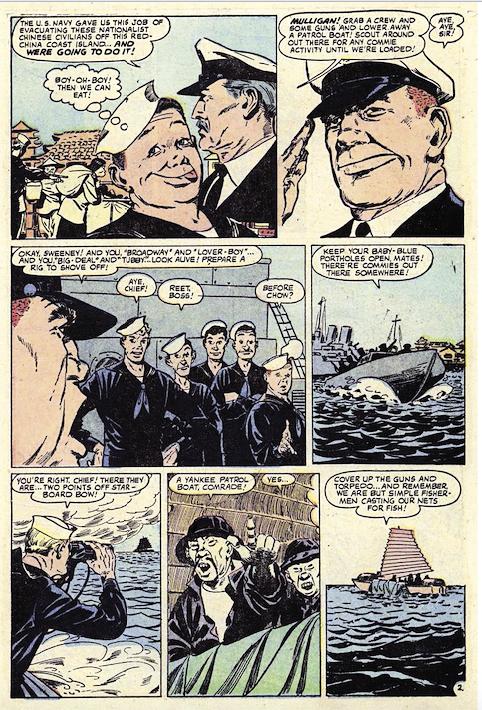
Sailor, Beware! One real gem, at least in terms of showing how well Syd Shores could draw, was the short-lived Timely war/adventure comic Sailor Sweeney, as per these two pages from issue #12 (July 1956). Syd drew Chinese people who looked as Chinese people might have when coming to America in those days—with not a racial caricature in sight (unless you count the tone-yellow coloring, which was simply an unenlightened convention of the day, with no ill will meant). Scripter unknown. [TM & © Marvel Characters, Inc.]
BELLMAN: That I can’t speak to. I know nothing about that.
Syd, I think, is really unrecognized for the contributions he brought to comics. What really angered me about Syd was that in the 1960s he was pushed back into being only an inker, and at Marvel, of all places. Here was one of the best guys ever to construct a comics page, and all he was allowed to do was ink. One of the worst things you could do to an all-around artist.
I’m not saying that Marvel didn’t already have good pencilers. They had Jack Kirby and Gene Colan. Very good pencilers. But Syd was not that far in quality from them. Quieter, maybe. Kirby was flashy. It’s just a shame that Syd was pushed back because they didn’t like his current style. It wasn’t fair. It was just sad.

RA: One of the things that should probably be mentioned here was that in 1967, when Syd came back to what was now Marvel Comics, they didn’t actually have that many books they could put him on. Kirby, Colan, John Romita, John Buscema, and Don Heck accounted for most of the penciled artwork for the titles at that time. The other pencilers of that time period— Can A Wolf Beat Marie Severin, Werner Roth, Larry Lieber, and A Bear? Dick Ayers—had been working for Marvel for This dynamic cover for Red Wolf years by then. That situation did change in 1968, #4 (Nov. 1972) surely proves Allen though, when they nearly doubled their output. Bellman’s point: that Syd Shores could probably have been better utilized BELLMAN: Maybe. I don’t want to put by Marvel penciling as well as inking down those fellas you mentioned. In fact, super-hero stories. Thanks to the GCD. God bless Jack Kirby for creating Captain [TM & © Marvel Characters, Inc.]
America. Best character he ever created. It still seems to me that Stan or somebody should have found a place for Syd to pencil and ink his own work. Having him just ink was pushing him back, because his 1940s “Captain America” work was just so good. Maybe Kirby was a better artist, but that’s no excuse for pushing a man as good as Syd was back. He was Marvel’s top artist at one time. To me, pushing Syd into only an inker’s role was cold and cruel.
RA: I’m sorry to hear you think that. BELLMAN: Maybe I’m wrong to put it like that. A lot of good artists, who just weren’t around during the 1960s and 1970s, are forgotten today. Just because they didn’t do their art on today’s popular characters or because they died before they could be recognized. Sam Burlockoff, an old friend of mine, should be written up, too. He did a lot of work for Timely—freelance. Also for Quality and Archie Comics. His daughter got in touch with me and sent me a picture of me and him.
RA: Syd did do some pencil and ink jobs for Marvel, mostly in 1972 or 1973, just before his death. He was doing anthology stories for the mystery titles and the black-&white magazines, as well as working on Red Wolf.

BELLMAN: That may be, but I had to speak my heart here. Marvel pushed him back as though he were a second-rate artist. He was not. I don’t think that Stan defended his artists like he should have. I remember Gene Colan telling me that he was getting a lot of grief from an art director at one time. He went in to Stan to see if Stan would sort out the problem and Stan did not defend Gene, either. In other words, he’d defend editorial before he’d defend the artists.
Another time, a rat went to Robby Solomon to say one of the artists in the bullpen took one piece of Bristol Board home and got that artist fired. Some of the artists just were not very nice, either.
RA: When Syd passed away, was that from a heart attack? BELLMAN: The story was that he was having chest pains. He was asked by his family, who told this to me, to go to the hospital, but he told them that the pain would go away. Instead, Syd went away. He was only about sixty. So young. To me, anyways.


Syd and I were best friends. Roz and I were often over to his house for dinner. We’d talk to each other about any problems we were having. It was a great relationship. He was a quiet gentleman, and he was a gentleman. He was also a great artist. I hope people recognize that. He just didn’t live long enough to be recognized by his peers and his fans. I’d like to see Syd Shores adopted into the Hall of Fame at the San Diego ComicCon. It’s about time.
Putting A Cap On It Future Mad artist Dave Berg drew the above caricature of Syd Shores for Stan Lee’s 1947 “how-to” book Secrets behind the Comics. Syd himself, of course, drew the slam-bang action page from Captain America #40 (July 1944 – scripter unknown) at top right—and the humorous illustration for a 1973 artists’ portfolio published by the industry’s own Academy of Comic Book Arts. [CA #40 page & Captain America TM & © Marvel Characters, Inc.; caricature © Estate of Stan Lee.]









